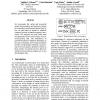Free Online Productivity Tools
i2Speak
i2Symbol
i2OCR
iTex2Img
iWeb2Print
iWeb2Shot
i2Type
iPdf2Split
iPdf2Merge
i2Bopomofo
i2Arabic
i2Style
i2Image
i2PDF
iLatex2Rtf
Sci2ools
ACL
2003
2003
Towards a Model of Face-to-Face Grounding
We investigate the verbal and nonverbal means for grounding, and propose a design for embodied conversational agents that relies on both kinds of signals to establish common ground in human-computer interaction. We analyzed eye gaze, head nods and attentional focus in the context of a direction-giving task. The distribution of nonverbal behaviors differed depending on the type of dialogue move being grounded, and the overall pattern reflected a monitoring of lack of negative feedback. Based on these results, we present an ECA that uses verbal and nonverbal grounding acts to update dialogue state.
| Added | 31 Oct 2010 |
| Updated | 31 Oct 2010 |
| Type | Conference |
| Year | 2003 |
| Where | ACL |
| Authors | Yukiko I. Nakano, Gabe Reinstein, Tom Stocky, Justine Cassell |
Comments (0)

